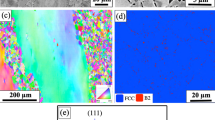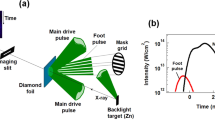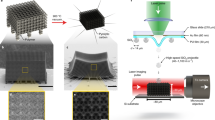Abstract
IT has been shown1–3 that at ambient temperature the hyper-velocity force per unit area of crater surface can be related to the engineering ultimate tensile strength of a material by the expression d3 = mv2/4πS where d is the depth (or radius) of a hemispherical crater, m and v are the mass and velocity of the projectile, and S is the measured ultimate tensile strength of the target. Aluminium alloys were divided4 into two groups on the basis of their ultimate tensile strength at room temperature; those having a strength of 4 × 109 dynes/cm2 or larger were not corrected for relaxation while those with strengths of 3 × 109 dynes/cm2 and less were increased by 25 per cent to obtain agreement between the target strength and impact force per unit area. The relaxation correction is an all-embracing term which includes the correction for relaxation of the target material after release of the impact pressure and other effects such as the error in the determination of the strength of very ductile materials caused by necking during loading.
This is a preview of subscription content, access via your institution
Access options
Subscribe to this journal
Receive 51 print issues and online access
$199.00 per year
only $3.90 per issue
Buy this article
- Purchase on Springer Link
- Instant access to full article PDF
Prices may be subject to local taxes which are calculated during checkout
Similar content being viewed by others
References
Rolsten, R. F., and Hunt, H. H., Amer. Inst. Aeronaut. and Astronaut. J., 1, 1893 (1963).
Rolsten, R. F., and Hunt, H. H., Spacecraft and Rockets, 351 (May–June, 1964).
Rolsten, R. F., Amer. Inst. Aeronaut. and Astronaut. J., 3, 11, 2149 (1965).
Gehring, J. W., Fourth Hypervelocity Impact Symp., Eglin Air Force Base, Florida, 2, 29 (1960); Eichelberger, R. J., J. Amer. Rocket Soc., 1583 (October 1962).
Piacesi, R. (personal communication).
Rolsten, R. F., and Schmitt, R. A., J. App. Phys., 34, 10, 3010 (1963).
Atkins, W. W., and Halperson, S. M. (personal communication).
Author information
Authors and Affiliations
Rights and permissions
About this article
Cite this article
ROLSTEN, R., HOPKINS, A. & HUNT, H. Hyper-velocity Crater Size and Target Strength. Nature 212, 495–497 (1966). https://doi.org/10.1038/212495b0
Issue Date:
DOI: https://doi.org/10.1038/212495b0
Comments
By submitting a comment you agree to abide by our Terms and Community Guidelines. If you find something abusive or that does not comply with our terms or guidelines please flag it as inappropriate.



